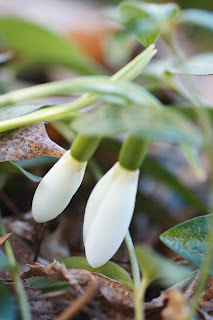 |
| Snowdrops are blooming early |
In recent years, I’ve noticed spring growth starting earlier. Scientific data confirms this trend is affecting wild plant populations. Our climate is changing, and gardeners are on the front lines.
 |
| Witch hazel buds are already opening |
I’m finding the lack of snow cover ominous this year. Is this the new normal? Last year demonstrated the kind of damage that our plants suffer when they experience blasts of cold weather without the insulating protection of snow.
The New York Times recently reported that farmers in Kansas are talking about changes in the weather, although many still don’t blame human actions for causing global warming. One farmer they spotlighted also spoke about sequestering carbon in the soil. On a much smaller scale, that’s something we can do too in our backyards.
Brooklyn Botanic Garden offers The Climate Conscious Gardener, a handbook of useful approaches for minimizing the carbon footprint of your garden and sequestering carbon in your soil and plants.
With Congress and the Trump administration rolling back restrictions on methane leaking from oil and natural gas rigs and wells, it’s even more important for us to seize the opportunity to be good climate stewards.
Methane is a greenhouse gas 21 times more potent than carbon dioxide. Federal regulations restricting its release were intended to fight climate change. Now with climate change deniers having their way, oil drillers and frackers hope to be spared the trouble and expense of preventing methane release. The planet and everyone on it will pay the price.
 |
| Gas flare from North Sea oil drilling--photo by Varodrig |
Some of the steps the BBG handbook recommends:
Planting trees. We’ve all heard about this as a way to keep carbon out of the atmosphere. Long-lived trees are best.
 |
| The dense wood of this tall white pine sequesters lots of carbon |
Siting trees and shrubs to provide windbreaks and shade. This will reduce your house’s energy needs for heating and cooling—and save you money.
Minimizing digging or, even better, switching to no-till gardening. When we dig, we introduce oxygen that speeds up decomposition of organic material, releasing carbon into the air.
Recycling fallen leaves and garden waste as compost. When you keep organic material at home as compost, you’re holding onto carbon.
Applying organic mulches. Mulches made from materials you can get close to home are especially carbon-thrifty. I like to mulch with shredded or whole leaves and arborist wood chips.
 |
| Wood chip mulch holds carbon |
Shrinking your lawn. Every other landscape feature requires less energy, petrochemicals, and water for maintenance.
Skipping peat-based potting mix. Peat bogs are a major carbon sink, sequestering more carbon worldwide than trees. When peat is extracted, carbon is released, and the carbon sink it provided is lost. It’s easy to make homemade potting mix from compost and coir (coconut fiber).
By following some of these recommendations, we can be part of the solution locally, even when the federal government is going in the wrong direction globally.
 |
| Neck deep in the Big Muddy |
No comments:
Post a Comment